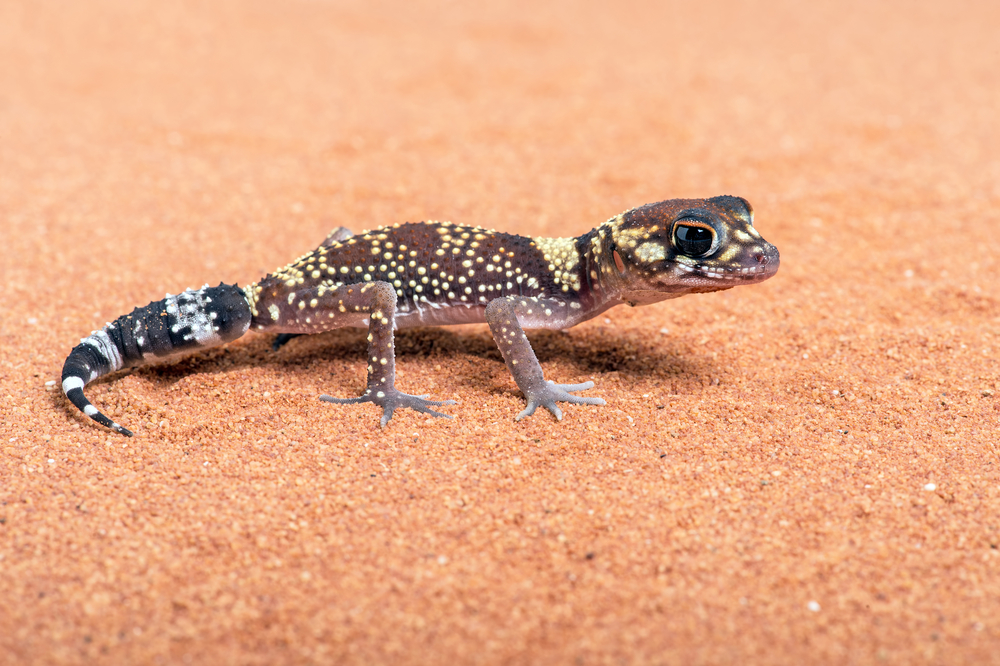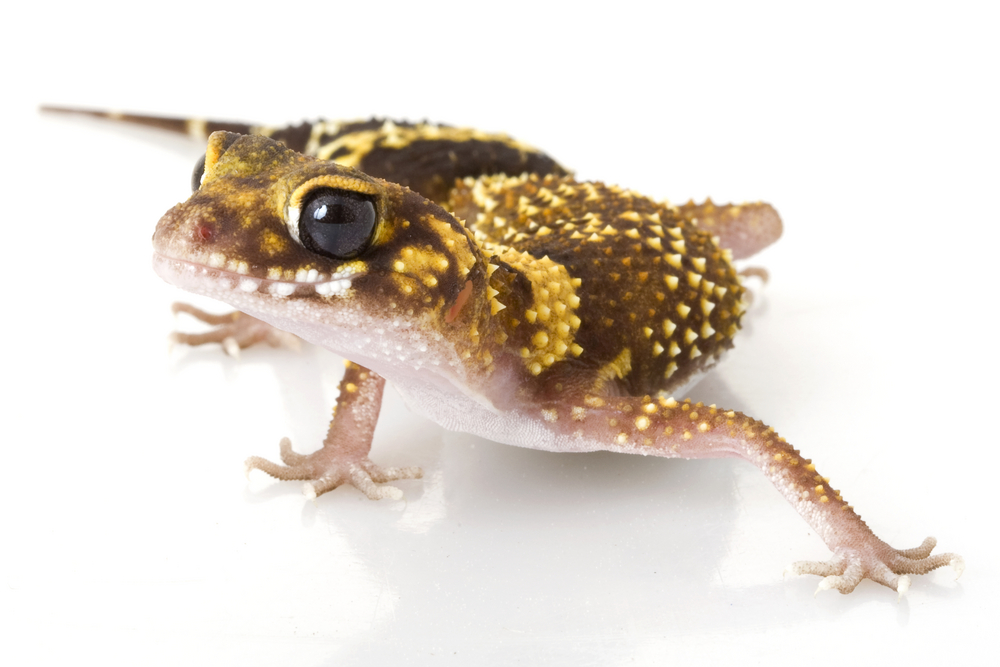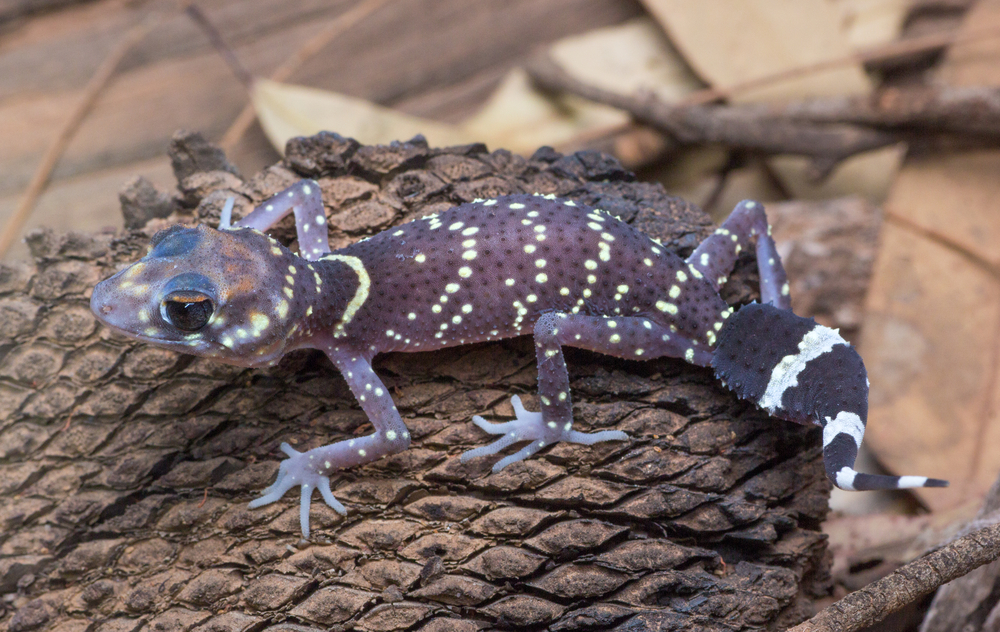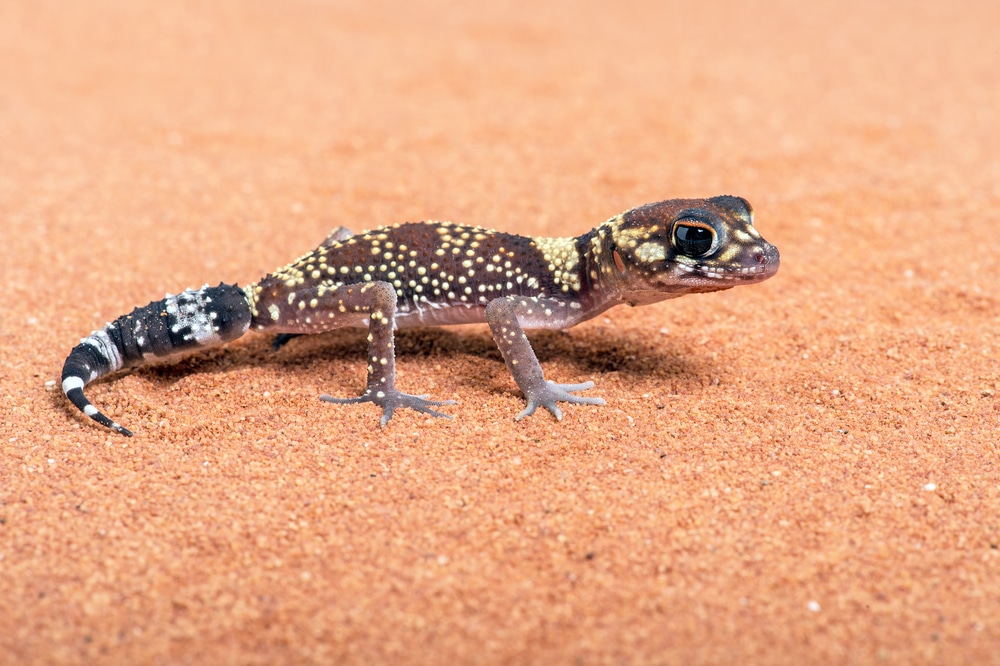Also known as thick-tailed geckos, the barking gecko is a great little lizard from Australia.
Let's imagine you are out in the early evening as the sun sets in the coastal area of southern Australia, strolling in scrubland with copses of eucalyptus trees, when you notice movement on the side of the trail on a rock surrounded by leaf debris. Slowly, you approach for a better look, getting the camera ready for a photo opportunity in case it turns out to be one of Australia’s wildlife treasures.
Upon careful and close observation, you find a small, maroon-brown lizard with large, doe-like eyes, feet with clawed toes that resemble those of a bird, an unusual pointed spear-shaped tail that is quite thick at the base, and a body covered with an array of raised white tubercles. As you point your camera to zoom in the lens, the little lizard suddenly turns in the blink of an eye and barks at you! Click! You got the image and preview it on your camera’s screen, wondering, "What is this”?

shutterstock/davemhuntphotography
These geckos like to live in group colonies and hide in concealed dwellings kept on the warm side of their enclosure, so a cave-like shelter should be provided.
What’s In a Name?
The Australian barking gecko, also known as the Australian thick-tailed gecko, has undergone a roller coaster ride in taxonomy, having been reclassified 22 times since its discovery in 1823. Its scientific name, most commonly recognized as Underwoodisaurus milii (pronounced under-wood-ee-sore-us mill-ee-eye) was overturned to Nephrurus milii in 1990, back to U. milii in 2000, again to N. milii in 2007, and is currently referred to as Underwoodisaurus milii, once again since 2011. Still loosely considered a knob-tailed gecko by most breeders and keepers, one name that commonly identifies this unique gecko is simply "milii.” In spite of the numerous efforts to figure out how to appropriately label them and properly pronounce their scientific name, these spunky little geckos remain unaffected by identity crisis—they know exactly who they are!
Natural Habitat
There are two major species of Underwoodisaurus—the most common is the western form (U. milii) and the less common is the eastern form (U. husbandi). Populations of barking geckos are found in a range of habitats, including wet coastal low-woody vegetation; shrubby, sclerophyll (leather-leaf) forests; rocky arid scrubland; and hills in eucalyptus woodland in the southern coastal regions of eastern New South Wales, and throughout southern Australia to western Australia. Available range maps are varied, and it might be speculated that the two species may overlap at some point thereby creating natural intergrades.
It is not uncommon to find barking geckos in rocky crevices and under vegetation debris in aggregate groups consisting of several adults, including multiple males, along with juveniles. It is theorized that the benefit of huddling in colonies helps in maintaining suitable body temperatures in order to avoid extreme lows at nighttime and highs during daytime by slowing their body’s heating and cooling rates.

shutterstock/fivespots
Keep in mind that barking geckos are avid climbers, so secure a cover for their enclosure.
Small and Attractive
Barking geckos are generally nocturnal, terrestrial lizards. Adults can reach a snout-to-vent length of approximately 4 inches, with a tail length of close to that, and adults can weigh an average of 14 to 20 grams, with some specimens weighing as much as 25 grams. The eastern form (U. hubandi) is typically slightly smaller. Their clawed feet are generally bird-like, with long slender digits, and their dark, banded tail is spear-head shaped, with a thick pad of stored fat at the base, tapering to a point at the end. The underside of the body is white, and the dorsal surface colors range from dark maroon through reddish-brown to pale fawn, and even golden orange, with a thicker white or yellow band around the neck. The body is covered in an array of patterns of small white or yellow raised tubercles. They have large, dark eyes with visor-like hoods. They are not truly dimorphic, as males and females tend to be of similar size. Preanal pores are absent in males, but their gender is obvious as adult males have disproportionately large hemipenes just under their vent at the underside of the tail base.
The overall body coloration of the Australian barking gecko might be classified in four distinct phases: dark, normal, light and ultra-light. Many breeders and keepers refer to only two color phases: either normal or light/hypo (hypomelanistic). The lighter phase geckos tend to "fire up” during the nighttime, exhibiting brilliant hues of golden orange. Attempts to determine if there is solid genetic basis for the variations in color phases have been ambiguous; some may consider the hypo-phase to be recessive, but not simple recessive. Pre-conclusive evidence leans toward incomplete dominance, with the normal phase being the default coloration. It is theorized that the darker-bodied morphs tend to come from the cooler, southern areas of Australia, where the landscape is more wooded, while the lighter-bodied specimens are found in the sandy, warmer northern regions of their ranges. Amelanistic (without melanin) specimens exist, but factual scientific reports on the presence or absence of melanin and tyrosinaise in the skin (T+ or T-) are elusive.
Big on Personality
The Australian barking gecko may appear to be fragile, but they are actually quite robust. These outgoing and congenial geckos are delightful little characters, full of personality and attitude. Being social creatures, they are more easily handled and observed than most other knob-tailed gecko species because they tend to stay out of their hiding places, even during daylight hours. Being quite vocal, especially during breeding and when annoyed, gives them their common name, barking gecko. This behavior includes standing tall with their tails rigid and barking, as they lunge at you in attempt to discourage and threaten you. Although they do not have the tendency to bite, if their guttural bark and comical display of feigned aggression is not heeded, you may be delivered a nip, which is usually of little consequence other than surprise.

SHUTTERSTOCK/ADAM BRICE
It is not uncommon to find barking geckos in rocky crevices and under vegetation debris in aggregate groups consisting of several adults, including multiple males, along with juveniles.
Australian barking geckos are prolific breeders in captivity if provided with optimal environmental conditions. Females begin ovulation in early spring, and they can produce clutches of two eggs approximately every 30 days through fall. A more detailed companion article on breeding Australian barking geckos can be read here.
Group Housing
Australian barking geckos can be housed in rack systems or in naturalistic terrarium-type habitats. As a general rule, allow a minimum space of 12 inches long by 12 inches wide of surface area per adult barking gecko. Given that they are primarily terrestrial, the height only needs to be 9 to 12 inches tall. These geckos like to live in group colonies and hide in concealed dwellings kept on the warm side of their enclosure, so a cave-like shelter should be provided. For more naturalistic environments, artificial plants, rocks and driftwood can be used. Keep in mind that barking geckos are avid climbers, so secure a cover for their enclosure. Although it is reported that multiple males and juveniles are found together in the wild, adult males should not be housed together in the same vivarium. A single male can be kept with several females, or several females without a male can share the same enclosure. Aggression over food or space is rarely observed. It is not recommended to house adult barking geckos with babies or any other reptile species.
Natural Substrates
Given that Australian barking geckos generally live in sandy, loamy soil, they do not have a tendency for intestinal impaction like many other gecko species that are not from indigenous sandy areas. Using a half to 1-inch layer of 50 percent fine-grade, non-silica sand and 50 percent sifted, sphagnum peat moss (without fertilizer!) in the bottom of the enclosure will provide a more natural substrate, allowing the gecko to dig and maintain appropriate thermal conditions and relative humidity. Keep an area of the cool side slightly moist by misting with water two to three times a week, allowing the gecko to lick droplets of water from the side walls, as they are not always inclined to drink from a bowl. Paper towel is also a suitable substrate, but it must be kept damp at the cool side, which can be problematic due to its absorbent nature.
Heating
All reptiles are cold-blooded and rely on the temperature of their surrounding environment to keep warm or cool. Use an under tank heater on the outside bottom of only one side of the gecko’s enclosure, thus allowing them to move back and forth within the enclosure to adjust their desired body temperature. This is known as thermal regulation, and it is critical for their metabolism, digestion and immune systems. Barking geckos cannot tolerate the high temperatures that some other terrestrial geckos do; ideal high temperatures are around 80 to 86 degrees Fahrenheit on the floor surface of the enclosure’s warm side and normal room temperatures of around 68 to 74 degrees on the cool side. Use under tank heating instead of overhead heat sources because they will only raise the ambient air temperature. Any commercial under tank heat tape or heat cable can be used, depending on the type of enclosure. Use a temperature controller in order to maintain ideal heating levels.
Avoid Direct Lighting
Unlike most other reptiles that bask in the sun to keep warm and to assimilate vitamin D from natural sunlight, barking geckos are mainly nocturnal so they do not require special lighting, as their skin and eyes are not adapted for strong ultraviolet rays. All they require is the indirect light from a room window to provide an efficient natural photo cycle. Be aware that barking geckos’ eyes are very sensitive, and their eyesight is poor in bright light. Keep in mind that additional overhead lighting will raise the ambient temperature in the enclosure. Never expose your gecko to prolonged direct sunlight, as it could cause damage to their eyes or even death.
Handle With Care
Australian barking geckos will tolerate moderate handling. When you must handle your gecko, keep your hand low and slowly extend it with the palm up. Avoid reaching down from above their head to grab them because they may become startled and think you are a predator coming down to attack them. Always handle your barking gecko with care, and never grab it by the tail. Like most lizards, when they are attacked or threatened, they can drop their tails. This is known as autotomizing, and the severed tail will continue to wiggle about to distract the hungry predator so the lizard can escape. When a lizard loses its tail, it becomes vulnerable to disease and infection until it grows a new one. Barking geckos will eventually grow new tails, but the regenerated ones are never quite as nice as the original.
Shedding
Reptiles shed their skin on regular basis, and barking geckos should molt about every two to four weeks. Unlike some gecko species, barking geckos do not eat their shed skin. It is extremely important that all the skin comes off, especially from the eyes (eye caps) and toes, as geckos can develop eye infections and lose their digits to infection if the skin does not completely shed. Soaking your barking gecko’s feet in about 1/2 inch of warm water and then use a cotton swab in a rolling motion to help remove any residual skin from their toes. Use a swab with mild saline solution or warm water to help take residual caps off of their eyes. Be very gentle! If shedding is a problem for your barking gecko, it may be necessary to increase the humidity on the cool side of the cage by moistening the substrate more or by placing a damp paper towel inside the hide.
Feeding
Barking geckos are voracious eaters and feed mainly on live crickets, roaches and occasional superworms. Giving your gecko a variety of foods is recommended, but barking geckos are not inclined to eat from bowls. Be careful not to feed a gecko anything larger than about three-fourths the size of its head. Any more than that and they could choke. Feed babies two to three small crickets or roach nymphs every one to two days until they reach about 2 inches in overall length, then they can be fed larger prey items every two to three days up until they become full-grown in about 12 to 18 months. Adults can be fed four to five larger crickets or roaches every three to four days. They will lick water droplets from the walls of the cool side of their enclosure after misting. A water bowl can be made available, but bowls are seldom utilized.
Supplements
Food items must be dusted with a mixture of ultra-fine calcium powder every two or three feedings, and dusted with reptile vitamins once a week. Calcium with vitamin D may be used every feeding for egging females and growing babies and without vitamin D for other adults. Put a small amount of calcium powder in a plastic bag or commercial cricket duster, add the feeder insects and shake them gently in the bag or container until they are coated. Vitamins should be given weekly using the same method. The health of your barking gecko is dependent on the proper supplementation of calcium and vitamins; otherwise, serious diseases can result. Metabolic bone disease (MBD) is caused by calcium deficiency, and it can permanently disfigure or ultimately kill your gecko. Keeping live insect feeders gut-loaded with nutritious food will transfer those nutrients to the geckos when consumed.
Future Development
There has been a steady increase in popularity for the Australian barking gecko during the past several years among gecko enthusiasts in the United States, Europe and now Asia. There are a growing number of gecko breeders working with this amazing species, making future availability less challenging and expensive. There is a concern that with the limited population of Australian barking geckos in the U.S., the gene pools may be fairly shallow. Obtaining potential breeding stock from Europe, or trading animals between breeders, could help with diversifying gene pools. Ideally, outcrossing with wild-caught specimens could strengthen genetic deficiencies caused by inbreeding, but Australia vehemently protects and conserves its natural resources—wildlife being at the top of the list. Wild specimens are simply not available to the U.S. market.
Further breeding statistics could prove the genetics of the various color mutations as defined by the reptile community. DNA testing and lab studies to determine if melanin and tyrosinaise (an oxidase, which is the rate limiting enzyme for controlling the production of melanin) in amelanistic specimens would be most interesting and beneficial.
Beautiful and Entertaining
Australian barking geckos are not only beautiful and entertaining, but easy to keep in captivity. They are a manageable size, do not require special lighting or elaborate heating, and are less likely to hide than other reptiles, making them fun to observe. Being voracious insectivores, it is unnecessary to prepare elaborate salads or fruit to balance their diet. As aggregate animals, several Australian barking geckos can be housed together in a tank-style habitat. Unlike many Australian knob-tailed species, the U. milii are less prone to stress and are easily handled. With a lifespan of more than 10 years, Australian barking geckos are quickly becoming a mainstream species and family pet. They are delightful additions to any reptile collection—truly darlings from Down Under!
MARCIA McGUINESS has had a special interest in reptiles and amphibians since childhood, and she is the owner of Golden Gate Geckos since 1995. Along with Australian barking geckos (Underwoodisaurus milii), she also keeps and breeds seven species of terrestrial geckos, comprised of Australian knob-tails (Nephrurus levis, N. wheeleri and N. amyae), leopard geckos (Eublepharis macularius), African fat-tailed geckos (Hemitheconyx caudicinctus) and western banded geckos (Coleonyx variegatus ssp). Her passion also includes her collection of green tree pythons (Morelia viridis) and Australian carpet pythons (Morelia spilota cheyne i and M. s. spilota). She lives in the San Francisco Bay area with her husband.
Other Geckos
Which Gecko Species Is Right For You?


